@CreativeTruth's July Garden Update 2020 [Gardening]
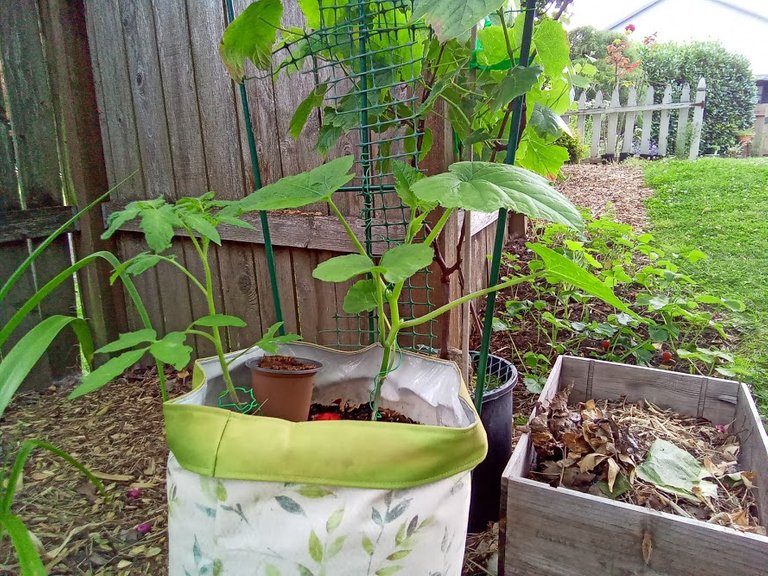
Here is a quick gardening update.
My plan here is to show each planting area and describe what is growing. At the end I'll give an overview of things I've discovered from observations.
On top I'm growing Momotaro F1 Slicing tomato (territorial seed company.
To the right is a sugar pumpkin I grew from seed. The little cup had another pumpkin sprout growing, but it failed a few days ago when the seed leaves were eaten off and the root system was too weak to push anything else up.
Both of these have almost doubled in size in the last week or so.
Grapevine and Strawberries
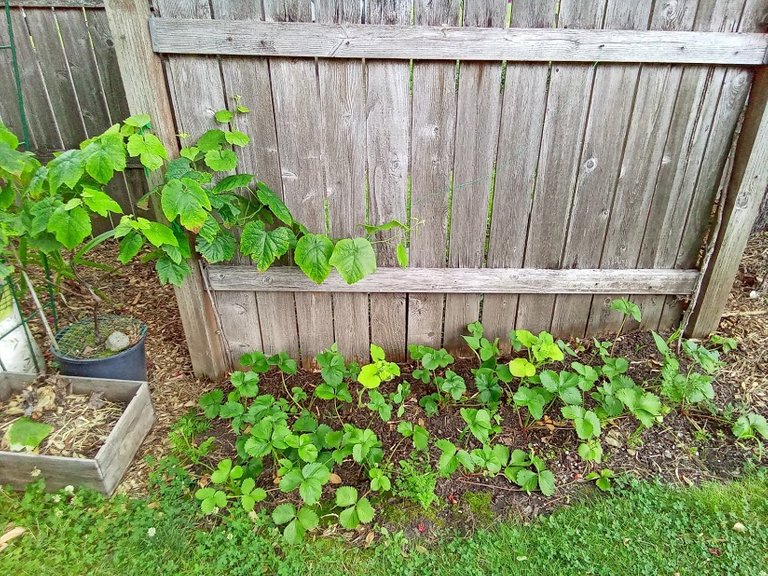
On the left my grapevine is growing well.
The strawberries have finished producing most of the berries, and they were delicious this year. Now they are sending out runners to form new plants.
The yellow green plants are two more pumpkin vines. I caved this year and purchased these from starts. Both male and female flowers are getting ready to open on all my pumpkin plants.
Pumpkin and More Surprises

Between the pumpkin and strawberries, there are a few nasturium seeds that grew into plants.
Corn is slowly emerging but many have not germinated.
Beans are also struggling to germinate. A few seem to have taken, while others were eaten away.
Carrots from seeds I sowed very late in the year, more like early June have had much better germination than any of the ones I planted in Spring. Of photo, I think I have good two foot clustered line of Atomic Red Carrots that will survive.
Scented Garden
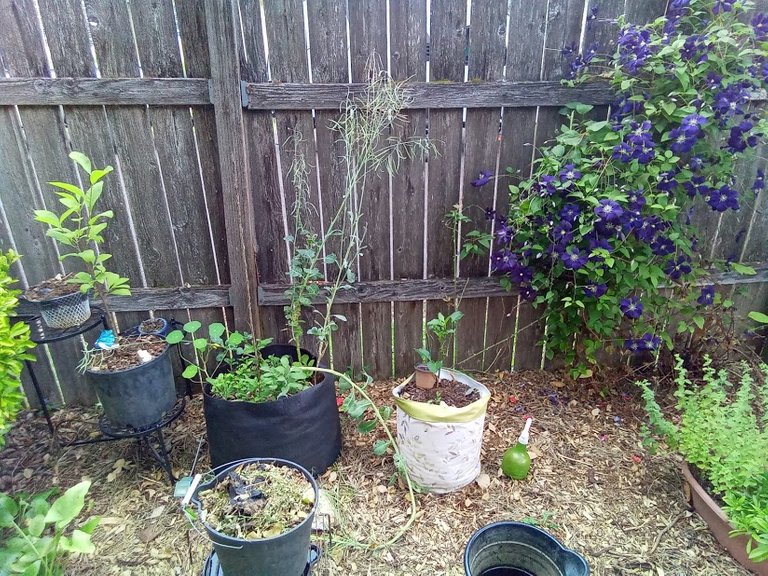
This area around the grow bag purple clematis flowers are in full bloom on the fence.
On the other side the new Osoberry (Indian Plum) shrub is looking healthy. When you pick the leaves, it smells like cucumber with a sweetness similar to watermelon.
On the Cabbage and Brussels Sprouts, the half the seed pods have fully matured. I have been opening the pods and scattering some of the seeds back into the soil.
Mint, Sage, and More

This grow bag is a crazy combination of the smelliest veggies and flowers. It's meant to be aphid and ant hell.
Lot's of spearmint. The sage I keep trimming off any leaves bigger than a spoon to make it bushier with smaller leaves.
There is a big nasturtium growing over the left edge.
Spring onions grow here, but they are looking like they are losing vigor. I trim them down to four inches every so often to prevent them from falling over.
A cluster of new Brussels Sprouts are growing small in the back. They need more rootspace, but I think the shade of the taller plants is protecting them from heat exhaustion and drying out.
In the back a cluster of nicotania is picking up the pace and growing much bigger leaves now. Soon it will outgrow the sage.
A few cuttings of lemon verbena were recently introduced. After first they looked limp, but now they have perked back up in the second week.
Pepper and Tomatoes
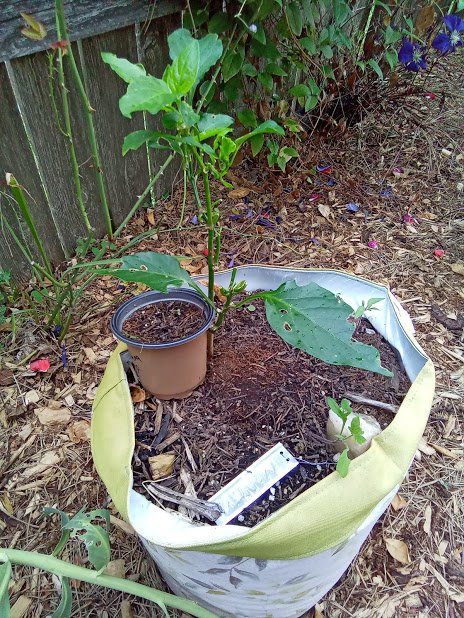
This funky pepper plant is one that survived over winter when I overwintered it indoors. I think this one is a mystery pepper because I lost the tag when it was transplanted indoors.
On the right side two tomatoes are growing. These are called Money Maker, which I think is a small type of tomato, almost a cherry. They are picking up a lot of speed this week, doubling in size.
The cup had a banana pepper, and it just recently failed. The top was chewed off by something. It was growing so slow, I think the root just ran out of growth juice.
Radicchio, Carrots, and Beans
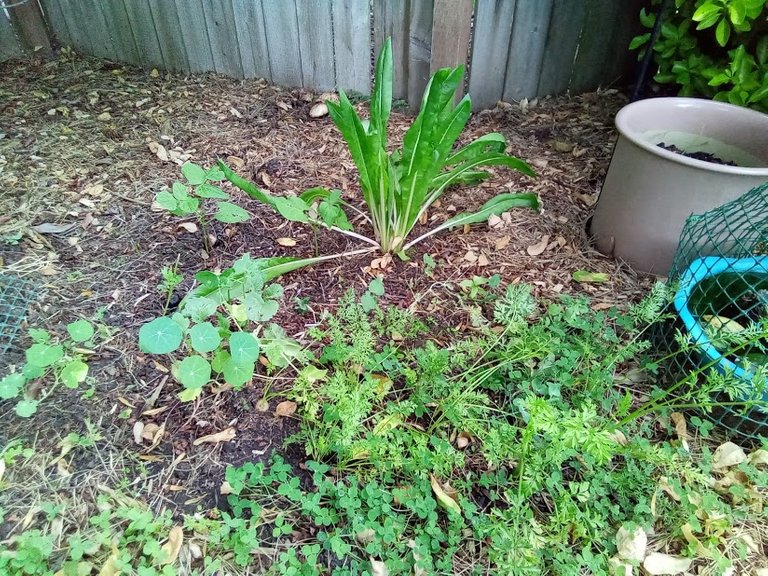
In the lower garden the Radiccio has formed a tall crown of leaves. It has established itself as the ruler of this plot. Mushrooms grow nearby, correcting the fertility of the soil, and decomposing the new wood chips.
Hidden between the nasturiums and clover, carrots from Spring seeds have grown very slowly. I can start to see the tops of the carrots pushing out of the ground, about as wide as nickles. I should harvest one soon to check on the progress.
Radish is also growing here, but many of them sort of faded.
In the background a bean plant has claimed it's territory in the good light. As the sole survivor, it is now growing a bit quicker in the recent conditions.
Garlic
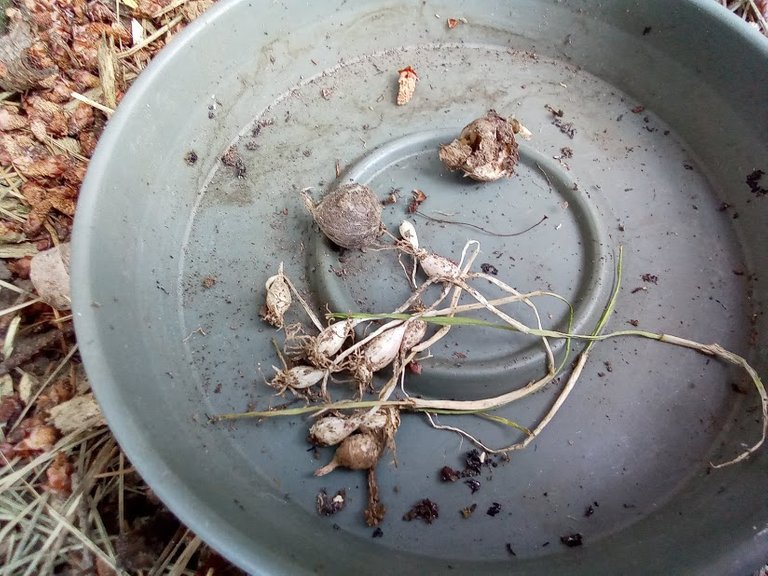
Not every garden adventure is a success.
I pulled the garlic out of the soil because the tops leaves were all turning brown, shrinking, and falling over.
The cloves look scrawny and weak. I put a plate over the top to protect from direct sunlight, and started to cure them in the fresh air for a week. Two kinds of garlic. I think the wider ones are called Mexican Violet garlic, and the others are from store bought produce.
Front Shade Garden
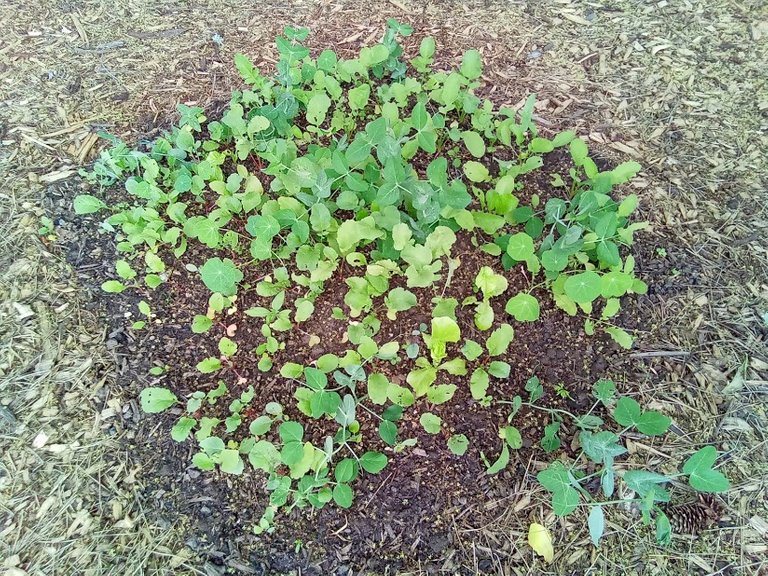
It's hard to believe this entire garden was only planted from seed about a month ago. The entire area was smothered in Spring when we had the wood chip pile dumped here.
Now the peas are starting to overtake the many radishes that proliferated here.
The three lettuce sprouts I had nursed along have established themselves in.
Even a few dwarf sunflowers on the perimeter are springing up. Everything is growing leafy greens, and nothing is bolting. Thank goodness, this one garden area is doing mostly what I intended it to be doing.
Front Wall Garden
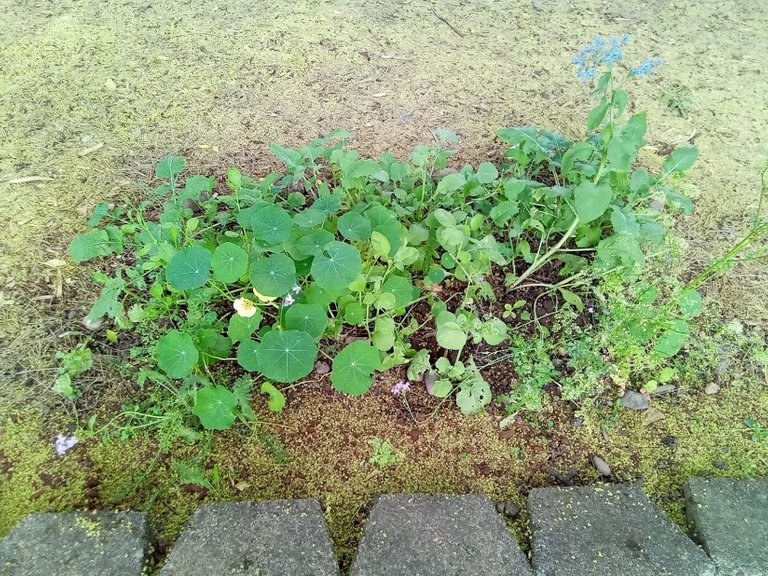
Borage on the right has reigned supreme here, in full flowering mode. That seed was a beast to get it to sprout, but eventually the early Summer seeds are the ones that germinated best, and it grew fast like a rocket.
At least two kinds of radish were planted here. In the front is a Japaense Daikon variety, but these seem to be a smaller bulbing kind, and not the large cone-shaped variety. In the back are a ruby red Champion radish. I should start harvesting some of these.
Naturtium is growing very large here.
On the right, this is the third year the same Parsley plant has been growing. I let it bolt as much as it wants, as it draws in helpful insects. Last year I divided the large root to make more plants, and it seemed to like that. Parsley roots drill down thick and deep into even the poorest soils, but they will grow even better in rich soil.
Carrots are hidden in this mess, and seem to be developing well in the shade of the taller plants. Slow growing carrots seem to be a good sign that the roots are growing well. Give them too much sun and the leaves grow fast, and then they bolt.
Radish, Beans, Carrots, Corn
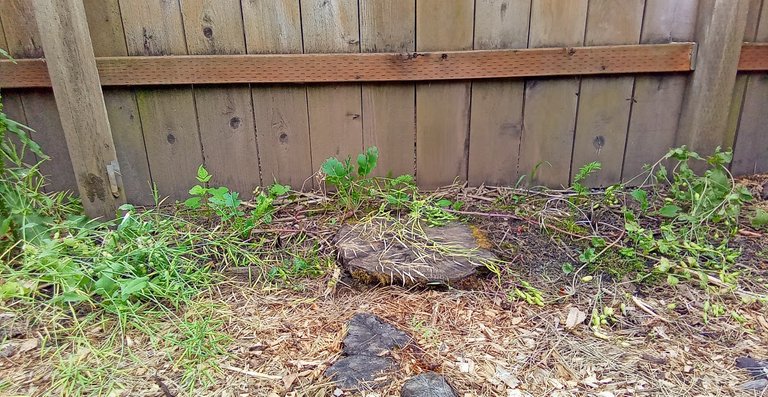
Hopping over to the back yard again, along the fence the radish grew very quickly and bolted through most of Spring. They seemed to like the muddy soil here with the full sun. Almost no insect damage to the leaves and seedpods. I'm still waiting for the sun to fully cure the seeds.
A few beans have sprouted along the fence. I was expecting a lot more seeds to sprout.
Same problem with the corn. You can't really spot much right now, but it's in there. Once corn clears the soil surface, it seems to have growth spurts every other week or so.
A little bit of carrot is growing here. I bet if I sowed some more in this mud, they would sprout quickly in this heat.
Tomatoes and Arugula

After cutting back all of the Arugula seeds, the tomatoes hardened off weeks ago, and now they are in full growth mode, ready to tower over the arugula.
It's nice to see that that the trimmed arugula is producing delicious new young leaves again. I love growing these because they come back every year, and spread more friends. Much less fuss to grow than lettuce and makes produce most of the year.
Left Grow Bag
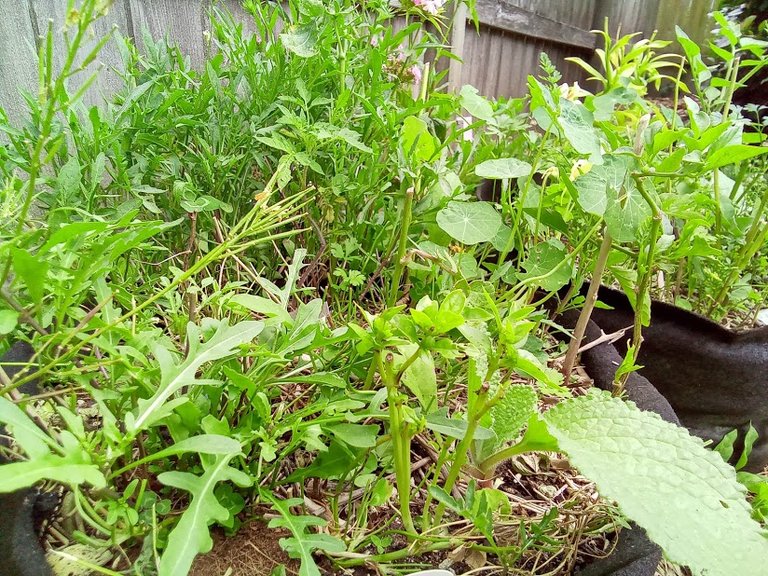
In the front a large leaf from another borage plant is peaking waving at us.
In front another overwintered pepper plant is growing. I think this one is labeled by I cannot read it. Either Ancho Poblano or Banana Pepper. It has lots of flower buds sprouting from all of the leaf nodes. I'm glad I got the timing right for this pepper to start it's fast growth now that mid-summer is coming up. It wasn't doing much during Spring.
Further back in front of the Arugula, a tomato plant is climbing up. There's is also another tomato plant hidden under the nasturium, and a young one hidden to the left out of view. I've got Heirloom Marriage Marzinera F1 (sauce/paste type from Territorial Seed Co.). A beefsteak tomato to the right. And I think it's another Marzinera hidden to the left.
Lots of clover here also as a green cover crop. Sprouts of what looks like either parsley or cilantro is also jumping up from the seeds lately.
Right Grow Bag

Another borage plant in the front is growing here.
I'm pretty sure the seeds are cilantro. I am very glad! Another smelly plant to ward away aphids.
Behind the bolting parlsey in the front, which I keep cutting back, there is a basil growing. It got eaten up by bugs a lot in late Spring after I planted it. It has lots of growth energy still, and has been quickly replacing leaves with new ones.
Center stage the Roma tomato has cleared the upper level of foliage even after I pruned the top. I did stake up the stem a bit because it was making a jagged shaped. It looks almost sturdy enough now to hold itself up. I like to grow tomatoes to form suckers, then fruit. Somewhere else in here, I think there is one other Roma reaching almost medium maturity, but not large yet.
I've got another one of my three overwintered peppers hidden somewhere in here too. It's loaded with flower buds.
Container Garden
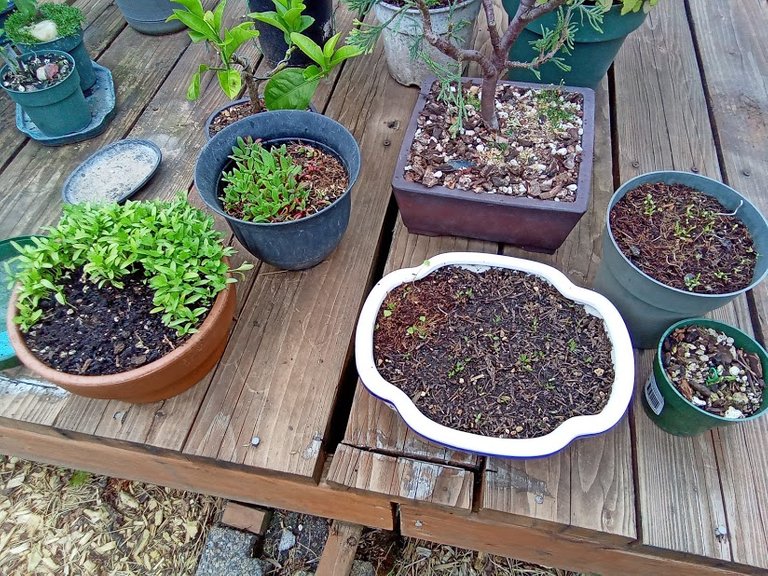
Cilantro on the left is growing very quickly. However there was one day that the sun scalded the sprouts in the front. They did not survive and turned brown, so I pricked them out the other day and sowed some new seeds into the bare spot. Many of the stronger sprouts developed one or two sets of true leaves.
I tried using the method used for growing the cilantro in the white ceramic pot to grow Anise. We're starting to see more sprouts there every day. Keeping it out of the shade now that the sprouts are emerging, because I know the slugs will get them if I move it off the deck.
To the far right, I've got little tiny sprouts of goji berry. Last year I had a bigger goji berry plant, but it did not survive the winter outside in a small container.
Livingstone daisies are growing in the black pot. Behind it a lemon bonsai tree has finally kicked out of dormancy and returned to life.
Swan River daisies are growing on the right side. Slugs keep finding their way back and mowing the tops off. I keep dumping in more seeds every time that happens.
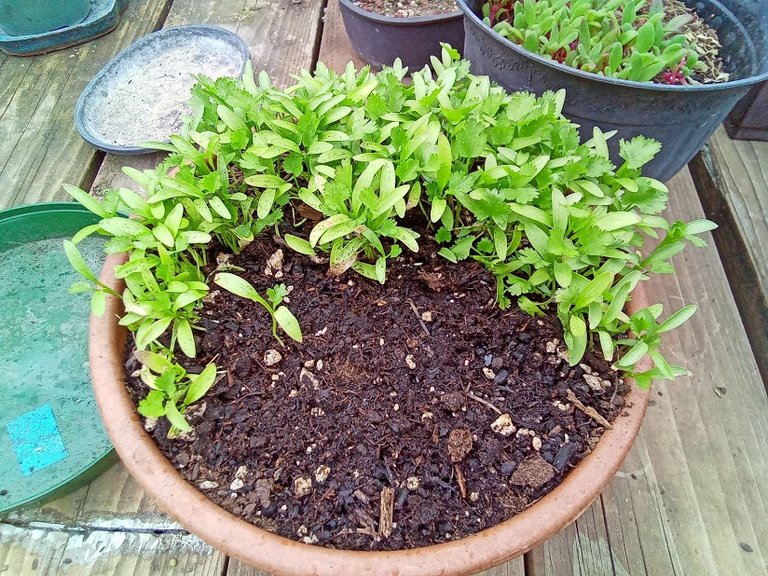
Conclusion, Observations, Lessons Learned
Cilantro: I finally learned how to grow lots of cilantro this year! Go read my article about how to grow it if you haven't already. I think it may also work well for similar seed types that form an initial hairlike taproot, like Anise, Parsley, Carrots, and Daisies.
Sunflowers: This is a terrible year for sunflowers. I don't see them growing in anybody's gardens this year, and I have many new seed packs I am using. Either there is something wrong with the soil, moisture levels, or air and temperature. Could worms and slugs be eating them before they clear the surface? My theory is perhaps the soil organisms are out of balance and are eating the seeds before they sprout. I'll have to keep sowing seeds every week, and hope the Summer changes conditions enough so more seeds will sprout.
Turnips: Also not sprouting. This is one of the plants I have always had a hard time growing. I usually get one or two that grow really well, and the rest of the seeds do nothing. Maybe I should start them in containers of super rich soil, like I did with the cilantro.
Corn: Timing is everything with this crop. I am not sure if I missed my window of opportunity here. I'm only seeing about 30% of the seeds I planted emerging. Last year I had 80-90%. Maybe I should inoculate the seeds a strong growth fertilizer to help kickstart them into breaking the soil crust.
Carrots: Everybody always says you can plant these in the cool season, but not in my yard. Once they emerge, it is just a matter of keeping them alive when they are most vulnerable. For me, that seems to be the Summer heat when carrots have the least threat of becoming a buffet dinner to slugs. Probably because it rains so frequently, and I water frequently in Summer. Perhaps the key to keeping young carrots protected is to keep the top soil very dry.
Borage: It seems to prefer the Summer heat, which causes it to grow at full speed. If planted in Spring, it does not seem to like cold temperatures or any shade.
Lettuce: It takes a long time to grow if you have to start it indoors, like I have to. Young sprouts draw slugs, like moth to a flame. Once are ready brought outside to harden off, the leaves will turn yellow and pale, so give then plenty of fertilizer and add rich soil. Wait for the leaves to turn deeper green again and form strong ribs before transplanting into the garden.
Garlic: I have no idea why my garlic shriveled up and shrunk. The shrub growing behind the area they were growing has been shedding a type of powdery mildew (I think) for the past year or so, and I have not yet discovered a way to prevent this. I suspect it is landing in the soil and making the roots and shoots of the garlic sick in the warmer weather.
Pumpkin: Once they get past the seedling stage, and are transplanted into the soil, they slow down growth for about a month. Same thing tends to happen if direct sown. This year, I'm lucky because I am seeing zero signs of leaf damage. Usually the slugs kill a couple of my plants, but we had a really sunny Spring, and I think that helped a lot. One of my pumpkins is being trained to grow up along a trellis. The two transplants I bought are growing strongly upright, and I am worried they might snap at the neck if they do not bend over soon. There are not any signs of powdery mildew on the leaves, but I might start spraying soon with a milk treatment to be on the safe side.
Oh! And there is a pumpkin I really want to grow next year, but when I looked online for seeds, it is considered very rare, and not always available. I'm in search for the Cherokee Tan Pumpkin seeds for next year. It is supposed to be a very aggressive vine with a wonderful flavor fruit inside. The Maine Sugar Pumpkins I always grow do not seem to be an ideal variety for my garden.
Peppers: The overwintered ones seems to be performing better than any peppers I have ever grown before. I'm seeing 10x more buds than I find on a first year plant. I think they will be loaded with fruit. As I recall, keeping them indoors was very challenging. Half of my crop did not survive. Especially late winter many peppers died off indoors, along with some of my citrus bonsai. I think the key is to treat them like by indoor plants, and water them very little (once a week) and keep the soil dry to allow them to grow slower. Don't try to grow them like a new seedling that needs moist soil, because it will rot the roots of a mature/woody plant. Moist soil indoors in winter also attracted a lot of fungus gnats/flies.
That's it! I just had to make a complete overview of my garden here, so I can keep track of the progress. Let me know if you learned something or observed anything interesting I might have missed.

I love plants. Especially vines and grape trees.
We started some garlic from store-bought cloves this year and had the exact same issue as you. I was surprised because we have wild onions that grow right in the lawn here during the fall and early winter when the grasses go dormant. I thought it would do better. I think I might try to start some garlic again in September to try to mimic those conditions that the onions seem to like. My theory is that it might get too hot in the spring and summer here for garlic to thrive.
I remember my father had some pretty wild success with turnips years ago (great lakes plain area of NY, a bit different climate and soil from the Piedmont area of NC I'm in now). He ended up with so much yield and nobody else in the family would eat the turnips so he had to give a bunch of it away. I wish he was still around to ask him what he did and relay the information.
He used to do weird stuff with his gardening sometimes. My brother and I had a contest with him one year to grow giant pumpkins and see who could grow the biggest one. We laughed as he put a piece of PVC pipe into the ground and fed milk to the roots (he did compost as well along with normal fertilizer). I just dug a deep hole and tilled in compost along with regular fertilizer. My brother was the laziest and just put his straight into normal soil and fertilized it once in a while. I came in second place but my father's pumpkin was more than twice the size of mine. I don't remember the exact weight, but it was heavy enough that we needed to move it around with the bucket loader on the tractor. I'm thinking maybe 400 lbs. Not a world record but pretty respectable for a first try.
Straight Milk for fertilizer? That is hilarious.
Awesome story.
Something weird you said reminded me about wild garlic that was growing all over my lawn one year. It seemed to sprout only in the mossy sod of the lawn. Maybe that says something about the type of drainage and moisture care it prefers.